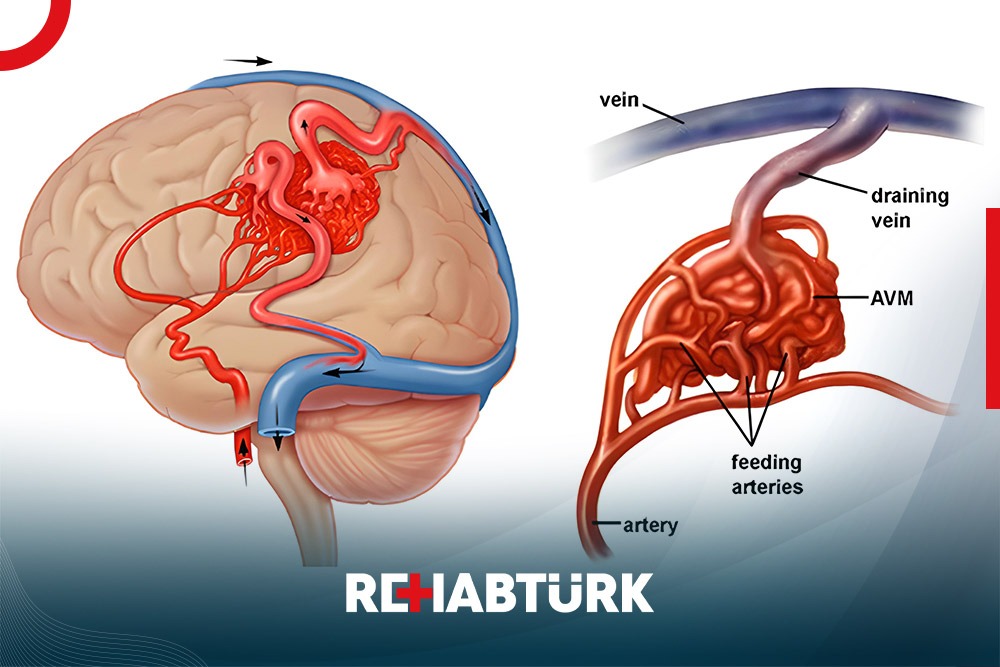Treatment of cerebral vascular dilation in Türkiye
Cerebral vascular dilation can be treated through surgery if there is a rupture or significant risk involved. Preventive surgery is usually recommended only if there is a high risk of rupture, as surgery carries its own risks and potential complications such as brain damage or stroke.
Assessment of risks associated with cerebral vascular dilation
If you have been diagnosed with cerebral vascular dilation, the risks will be assessed to determine whether surgery is necessary or not.

The assessment process usually considers the following factors:
- Age: Research has shown that the risks associated with surgery often outweigh the potential benefits for elderly individuals in terms of life expectancy.
- Size of vascular dilation: Vascular dilation larger than 7 mm often requires surgical treatment.
- Location of the vascular dilation: Vascular dilation on major blood vessels in the brain increases the risk of rupture.
- Family history: Cerebral vascular dilation is more prone to rupture if there is a family history of cerebral vascular dilation.
- Underlying health conditions: Certain health conditions, such as polycystic kidney disease or uncontrolled high blood pressure, increase the risk of rupture.
After considering these factors, your surgical team should be able to inform you whether the benefits of surgery outweigh the potential risks in your case.
Active observation
If the risk of rupture is low, active observation is usually recommended.
This means that you will not undergo immediate surgery but will undergo regular examinations to carefully monitor the cerebral vascular dilation.
You may also be prescribed medication to lower blood pressure.
Your doctor will discuss lifestyle changes that can help reduce the risk of rupture, such as weight loss and reducing fat intake in your diet.
Treatment of cerebral vascular dilation
If preventive treatment is recommended, the two main techniques used are surgical nerve cutting and vascular coiling.
Both techniques help prevent rupture by stopping blood flow to the dilated blood vessels.
Nerve cutting surgery:
- Nerve cutting surgery is performed under general anesthesia, meaning you will be asleep throughout the procedure.
- Incisions are made in your scalp or sometimes directly above your eyebrows, and a small portion of bone is removed to allow the surgeon access to your brain.
- When the vascular dilation is identified, a small metal clip is permanently placed on the dilated blood vessel, and the scalp is stitched.
- Over time, the lining of the blood vessel along the clip heals, leading to permanent closure of the vascular dilation and preventing its growth or rupture in the future.
- Cutting the artery on which the blood vessels are formed is rarely necessary, unlike cutting the blood vessels themselves, and is usually done only if the vascular dilation is large or particularly complex.
- When necessary, it is often combined with a procedure called bypass, where blood flow is redirected around the clipped area using blood vessels removed from another part of the body, usually the leg.
Endovascular coiling:
Endovascular coiling is usually performed under general anesthesia.
The procedure involves inserting a thin tube called a catheter into the artery in the leg or thigh.
The catheter is guided through the network of blood vessels, reaching your head, and finally the site of the vascular dilation. Small platinum coils are then passed through the tube into the dilated blood vessel. Once the blood vessel is filled with coils, blood cannot enter it.
This means that the vascular dilation is closed off from the main artery, preventing its growth or rupture.
Comparison between coiling and cutting in cerebral vascular dilation surgery
Whether cutting or coiling is chosen often depends on the size, location, and shape of the vascular dilation. Discuss the treatment options with your doctor, and if both procedures are possible for you, you should discuss the risks and benefits of each.
It has been generally proven that coiling is less prone to complications, such as strokes, compared to short-term cutting, although the long-term benefits are not fully confirmed. With coiling, there is also a small chance that you may need to undergo the procedure more than once to reduce the risk of vascular dilation rupture.
Approximately 1 in 5 people undergoing coiling may require additional treatment. However, since coiling is a less invasive procedure, you can usually leave the hospital after the operation. After a cutting procedure, you usually need to stay in the hospital for a period ranging from 4 to 6 days, while with coiling, you can typically return home after a day or two.
The complete recovery time is usually shorter with coiling. Many people recover within a few weeks of coiling, while recovery from cutting may take longer.
Emergency treatment and interventions for cerebral vascular dilation
If you require emergency treatment due to a rupture of cerebral vascular dilation, you will initially be given a medication called Nimodipine to reduce the risk of severe blood supply failure (cerebral ischemia) to the brain. Coiling or cutting may then be used to repair the cerebral vascular dilation. The choice of technique is usually determined by the expertise and experience of the available surgeons.
In emergency cases, the differences between techniques are less significant because factors such as recovery time and hospital stay depend more on the severity of the rupture than the type of surgery performed.
Treatment of cerebral vascular dilation in Türkiye
The medical staff of surgical teams, doctors and consultants in REHABTÜRK can provide the best treatment options and free consultations – by striving to keep abreast of the latest medical technologies and methods.
